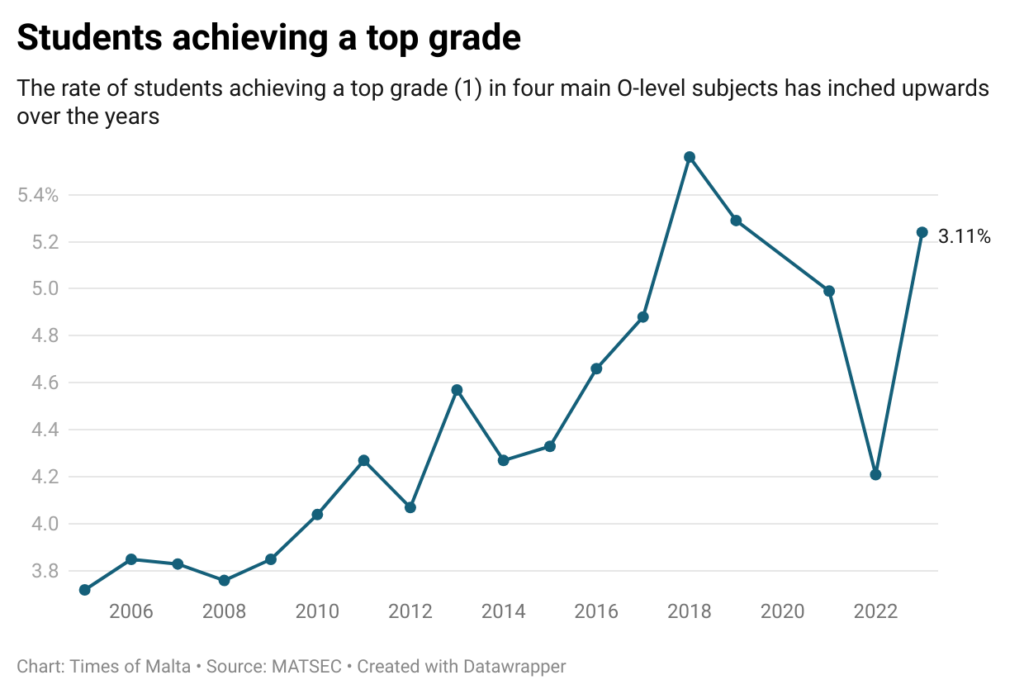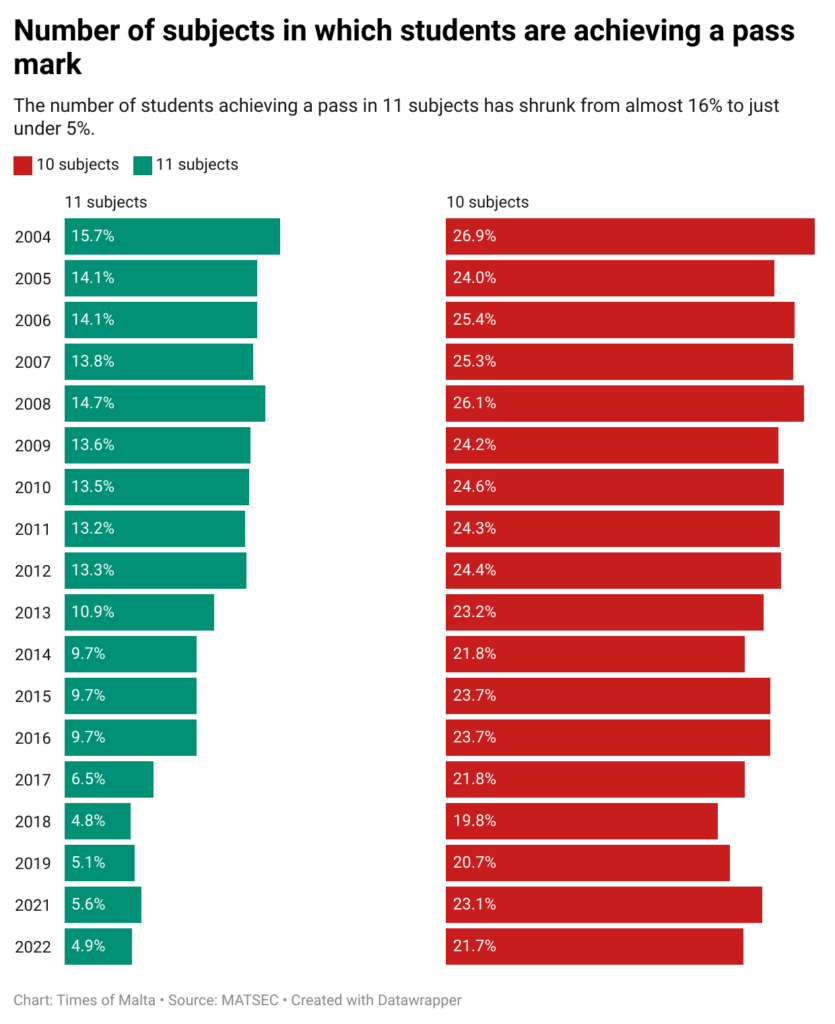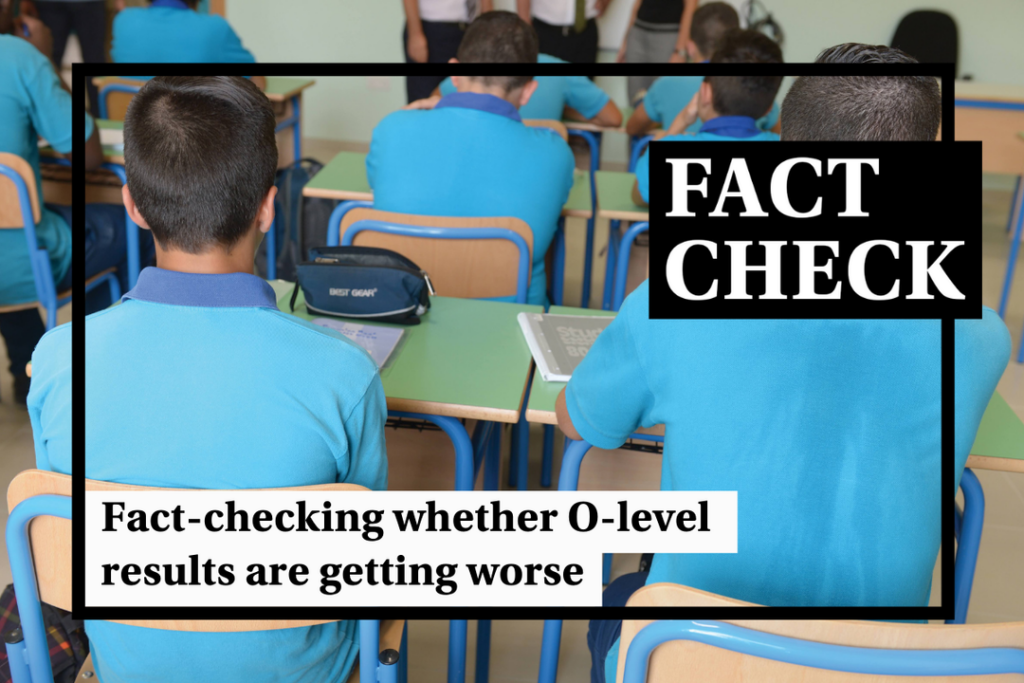Recently published O-level exam results prompted several professional and children’s organisations to express concern about declining educational standards amongst students completing their secondary education.
O-level exams, formally known as Secondary Education Certificate exams, are held at the end of a student’s secondary education, usually when they are at the age of 16.
The results showed that a fifth of all students received an unclassified ‘U’ grade, while almost a third received failing grades.
O-levels are graded over a number scale between one to eight. While grades 1-8 are all formally considered passing grades, most sixth forms only accept students with grades between 1-5, with grades 6-8 being considered insufficient for students looking to further their education.
The Malta Federation of Professional Associations expressed its alarm, saying that the results show that many students “are struggling to reach the minimum standards”. Likewise, MaltaCAN, a group of 14 children’s organisations, described the results as “worrying”, calling for comprehensive education reform.
A recently-published opinion piece in the Times of Malta by academic Dominic Cortis took a different view, arguing that some results indicate that students are actually doing better than in previous years.
Are grades really going down?
An exercise carried out by Times of Malta suggests that this may not be the case, although a more thorough analysis of MATSEC’s data would likely reveal additional nuance.
MATSEC’s reports present a wealth of data dating back to 2004, breaking down exam results across gender, the different towns in which students reside, and different private, public or Church schools, amongst other things.
Times of Malta looked into the results of four core subjects – English language, Maltese, mathematics and physics – over a span of two decades from 2004 to 2023 in an attempt to understand how grades have changed over this time.
This exercise focused on the main exam session from each year, usually held in May. It excludes the results of 2020, when the pandemic forced authorities to scrap the session and replace it with a one-off mechanism to predict students’ results.
For the purpose of this exercise, grades 1-5 are considered pass marks, while grades 6-8 and U are considered a fail grade.
More top marks, fewer failed grades
The percentage of students who achieved a top grade in these four core subjects has inched upward over the years, climbing from 3.1% in 2004 to 5.2% this year. This figure generally hovered under 4% until 2010, eventually climbing to a peak of almost 5.6% in 2018, before dipping marginally over the past few years.

More broadly, students are nowadays more likely to be awarded one of the top four grades. Almost 46% of students achieved these grades this year and again, this figure climbed upwards over the years, starting off at roughly 40% in 2004 before hitting a peak of just under 50% last year.
On the other hand, the percentage of students receiving a fail grade of either 6, 7 or ‘U’ appears to be dipping, losing six percentage points to now reach just over 33%.
While the share of students receiving a ‘U’ grade has remained relatively stable, those receiving a grade of 6 has almost shrunk by half, from a little under 12% in 2004 and 2005 to under 7% over the past two years.

Free exams
Some have wondered whether the fluctuation in exam fees over the years could have had an impact on exam statistics. Fees were raised in 2014, only to start being phased out a few years later and scrapped altogether by 2018.
Authorities have previously said that exams being free has led to a rise in absenteeism. Meanwhile, writing in Times of Malta, actuary Dominic Cortis argues that this has likely encouraged people who would previously not have applied for an exam to give it a go (a group he refers to as YOLOs), possibly leading to higher fail rates across the board.
Could this really be the case?
To factor out Cortis’ YOLOs, we filtered the data to exclude all students who were older than 16 at the time when they sat for their O-level exams.
The results suggest there may be some truth to the YOLO theory, although not enough to significantly change the overall trend.
16-year-olds tend to fare slightly better than the average, scoring a higher share of top marks, passes with a mark between one and four, and fewer fail grades. This indicates that overall figures are being held back slightly by the lower average of Cortis’ YOLOs, although this is likely not a hugely significant issue.
Generally, the trend amongst 16-year-olds tends to be similar to that of the overall figures, namely that grades have inched upward over the years and fail rates have decreased.
Better grades, but fewer exams
Although students appear to be receiving better grades in core subjects, the data also reveals that they tend to be passing fewer exams on the whole.
While it used to be customary for around a quarter of all students to receive a pass mark of one to five in at least 10 subjects until 2012, this has dipped over the past decade. Now, just over one in five students manage a pass mark in at least 10 O-Levels.
This dip is even more marked when it comes to the number of students achieving a pass in 11 subjects, which has shrunk from 16% in 2004 to under 5% in 2022.

Easier exams or more selective students?
Some have argued that exams have gotten easier over the years, suggesting that any possible improvement in exam results is a result of lowering standards.
Similar arguments have frequently been made elsewhere across Europe, particularly in the UK, where authorities actively sought to make A-level exams more difficult. However, others believe that there is too little research to suggest whether this is really the case. Likewise, suggestions that exam standards have slipped in Malta are mostly anecdotal, with almost no formal research into the subject, making it difficult to gauge whether or not this is the case.
What is almost certainly the case, as suggested by MATSEC data, is that students are being more selective in the number of subjects they sit for, often opting to drop some subjects to focus on others.
Verdict
Grades in four core subjects have improved slightly over the past two decades, with more students achieving top grades and lower fail grades, on the whole.
This is true of both the total number of students who sat for exams each year, as well as for students who were 16 years old at the time of the exam.
However, students are also achieving a pass mark in fewer O-Level exams than they used to. Until 2012, 27% of students each year passed 10 exams. Today, only 21% do so.
The Times of Malta fact-checking service forms part of the Mediterranean Digital Media Observatory (MedDMO) and the European Digital Media Observatory (EDMO), an independent observatory with hubs across all 27 EU member states that is funded by the EU’s Digital Europe programme. Fact-checks are based on our code of principles.
Let us know what you would like us to fact-check, understand our ratings system or see our answers to Frequently Asked Questions about the service.





